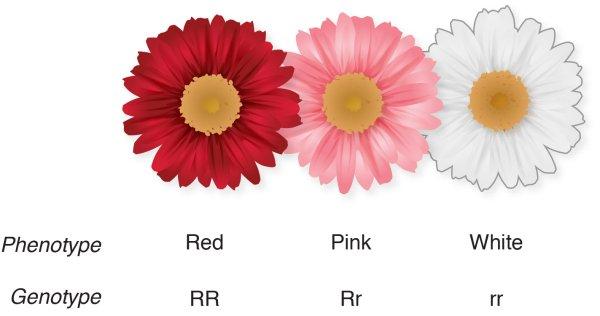The study of heredity is not easy. So many big names have contributed in making it much more understandable, and one such name is of Gregor Mendel who explained the concept of dominance. The traits you get from your parents usually depend on how many dominant or recessive alleles you get from each parent. However, there is another concept of co-dominance.The thing is that the relationship of genotype to phenotype is not as simple as identifying recessive and dominant patterns. Modern day biologists have identified relationships between different alleles that code for the same trait. These allelic interactions complicate the whole concept of inheritance because they are not exclusively dominant or recessive. This gives rise to the concept of incomplete dominance and codominance. Keep reading to learn more about the difference between incomplete dominance and codominance.
Incomplete Dominance
An organism’s genes will create phenotype that is affected by dominance, but it never affects how these genes are inherited. When it is not possible to tell the difference between the homozygous phenotype and the heterozygous phenotype, it's called complete dominance. In some cases, the heterozygote will have a phenotype that is in between the phenotypes of both parents (one of this will be dominant and the other one will be recessive). This intermediate phenotype is called incomplete dominance. In this case, the offspring may show a variety of phenotypes along a continuum bracketed by the parental phenotypes.
Take an example of two flowers, one of white color and the other one of red. None of these colors is fully dominant. When a cross is made between homozygous white flowers and homozygous red flowers, it will result in a variety of pink-shaded phenotypes. It is still important to understand that partial or incomplete dominance is not the same thing as blending inheritance. The main difference is that how these alleles are inherited won't change, but the way these alleles explain phenotype will be different when they are combined.

Codominance
In order to understand the difference between incomplete dominance and codominance,it is important to understand exactly what codominance means. It actually refers to a situation when the phenotypes of both homozygous parents are expressed at the same time. In simple words, it occurs when the offspring receives an allele from each parent but the offspring demonstrates both phenotypes. The human ABO blood group system is a good example of codominance.The types of blood proteins determine your blood type, and the ABO protein system means you can only receive specific type of blood in a transfusion. Not paying enough attention to the blood proteins in a person's blood cells will lead to serious complications.
In the ABO system, there are three basic alleles, and they are further segregated into six genotypes. Here's a table explaining blood types and possible ABO genotypes.
|
Blood Type |
Related Genotype(s) |
|
A |
AA or AO |
|
B |
BB or BO |
|
AB |
AB |
|
O |
OO |
It is clear from the table that the six possible ABO genotypes can result in four phenotypes. To understand this phenomenon, it is important to first understand the A and B alleles code for proteins available on the surface of your red blood cells – also bear in mind that the third allele (O) codes for no protein. It means that if one parent has type A blood and the other one has type B, the child will have a new phenotype called type AB. It also implies that it is possible to notice the equal amount of A and B proteins on the surface of red blood cells in a person with type AB blood. It means you cannot tag this phenotype as an intermediate of the two parents, but it’s a completely new phenotype, which is the outcome of codominance of the A and B alleles.
Difference Between Incomplete Dominance and Codominance
It would be easier to understand the difference between incomplete dominance and codominanceby paying attention to a few important points. Here's a table for your understanding:
|
Incomplete Dominance |
Codominance |
|
You will notice that the effect of one allele will be more noticeable |
Effect of both alleles will be equally noticeable |
|
You see the fine mixture of the expressions of both alleles |
You won't notice any mixing of the effect of both alleles |
|
You will notice the effect in hybrid is in the middle or intermediate of both alleles |
Both alleles will express them independently |
|
The expressed phenomenon won't have any allele of its own |
The expressed phenotype will show the combination of both alleles and phenotypes |
|
Any incompletely dominant allele will have quantitative effect |
There will be no quantitative effect |
